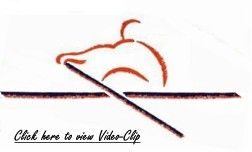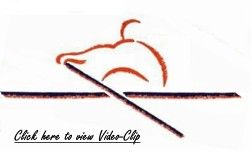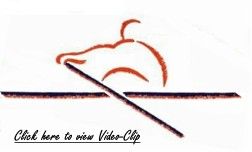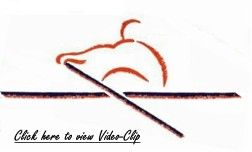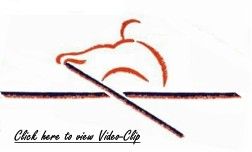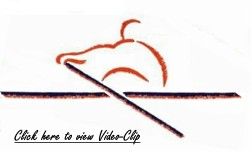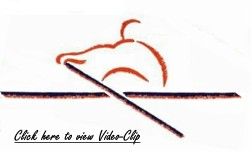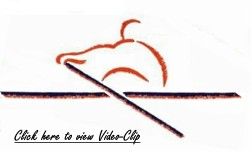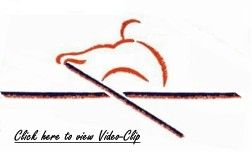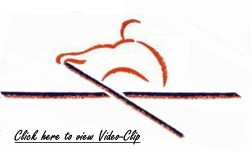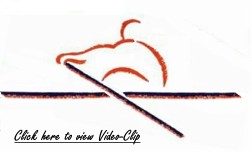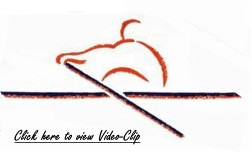 |
Rowing - Specific Scripts / Technique
4 Principles for an Effective Stroke in Watersport / 4 Thesis for an Efficient Rowing Technique / Rowing Technique / Sliding Forwards / Making typical rowing-mistakes visible on a C-II / Slide Control / Biomechanics 1/ Biomechanics 2 / The Physics and Physiology of Rowing Faster / Pulling Too Hard and Inefficient / Beginners Rowing / Technical Workouts / How to Produce a Good Rowing Video / Checklist for Rowing-Videos / Catalog of Common Mistakes
Catalog of Mistakes ���~�@���� -
To see, analyse and intervene �[��,���R,�ﵽ
Catch ���� ( 1-5 )
Drive �Լ� ( 6-14 )
Finish �Լյ��� ( 15-19 )
Recovery �^�� ( 20-24 )
The Catch �J�� / ����
1. Not enough reach forward �W�駤���Ӫ�
Effect �v�T
�E Way in the water too short �b�����ɶ��ӵu
�E No economic stroke and bladework �ո��@�\�ΦE�դ��X
�E Not enough run �ո��X����J������Z������
Causes �l�]
�E Wrong position of the stretcher ���~�����i����
�E Body too upright ����Ӫ�
�E Body stays too long in the finish-position after the release ����b���P����,�����Ӥ[���Լձ���������
Correction �B��
�E 1 �V 3: Demonstrating and explaining the correct movements out of the movement imagination of the coach ( concerns all following mistakes ! ) 1-3 �нm�ݹϥܨø������T���ʧ@,�å]�[�Ҧ������~
�E 1: The adjustments of the boat has to be all right ( concerns all following mistakes in trimming ! ). ��վ�n����,�ݦҼ{��Ҧ����p��
�E 2 / 3: One stroke rowing out of the catch position, after the release rest in the 90 degree-position, repeat several times, then rowing with counting ( catch out of the recovery, clean extraction with exaggeration of the fast hands over the knees, rest there, balance, beginning to slide after counting and then catch ). Rowing with fixed seat and extreme long reach forward, arm natural stretched, normal head position.
2. Extreme long reach forward �۷������V�e�V�~���i
Effect �v�T
�E Leads to missing relaxation of the body between stretcher and inboardpart of the oar ( „leg kick alone only�� ). �y�����i���M�ո����`�������骺���P����
�E Body gets a too low position in the boat ( diving ), what can result in more bouncing of the boat. ����b��W�����դӧC( ),�|�˭P���h���ϼu
Causes �l�]
�E 1. Jerky stopping of the slideseat before the catch �J���e�Ʈy���í
�E 2. Wrong position of the stretcher ���i����m���~
�E 3. Knees wide open at the catch �J���ɽ��\�Ӷ}
Correction �B��
�E 1: Rowing with counting, focus on slowslide and quickly catching the water out of the recovery. ��E���,�M�`�b�C�C�ƭy,�M��^��,�ֳt�J���C
�E 3: Half slide rowing with low stroke frequence, slowly increasing onto fullslide, while focusing on closed knees.
�C���W��,�b�ƭy���E��C,�b�`�N�A�M�l������,�C�C�W�[�ܥ��y�C
3. Too much or too early bended arms �Լծɤ��u�Ӧ��s��
Effect �v�T
�E stroke too short at the catch �J���ɦE�դӵu
�E Blade dives too deep after the catch �J����ո��I���Ӳ`
�E Arm can not hold the loaded pressure in the middle-part of the stroke �E�զܤ@�b��,���u�L�k�Ө��O�q
�E Body-action begins too late, and tendency to kick only with the leg ���骺�ʧ@�}�l���ӺC,�Ӧ��u�θ}���ɦV
�E No efficient use of power in the drive �L�ɤO�𤣨�
Causes �l�]
�E 1. Balance problems �����D
�E 2. Cramped use of the arms at the catch �J���ɤ��u�ӯ�
Correction �B��
�E 1: Balance workouts: ���ŹB��
- out of the layback with fixed seat fast hands �V balance����,�y�ȩT�w,����֦E�X����
- out of the layback fast hands and beginning to slide �W����,����֦E,�ö}�l�ƭy
- out of the layback fast hands, beginning to slide and 1 stroke �W����,����֦E,�}�l�ƭy�B�E�@�Ӽ�
- rowing with counting, focus on the pause ��E���,�`�N���y
�E 2: Fixed seat, let the oar drift through the drive with natural bended arms at the beginning of the stroke and correct bodywork, slowly increasing power and slide. �T�w�y��,�L�����կB�}�b���W,�E�ն}�l��,���u�h�۵M���s���M���B�����髺��,�C�C���W�[�O�q�ηƭy�C
4. Hands too low at the catch (skying ) ���ծɤ�U���]���ա^
Effect �v�T
�E Missing water ����
�E Too short stroke at the catch �J���ɦE��ӵu
�E Blades dive too deep �E���I�Ӳ`
�E Discreasing driveway and run �L�β�t�U��
Causes �l�]
�E Balance problems �����D
�E Cramped shoulder action �ӻH�ʧ@�ӯ�
( not enough mobility in the shoulder joint at the catch / �J���ɪ����`�ʧ@����)
�E Wrong adjustment of the boat ��վ���~
Correction �B��
�E 1: see balance workouts at picture 1 �ѬݹϤ��@�����ŹB��
�E 2: special gymnastics toget more mobility into the shoulder joints ���ǯS��������������`���ʼW�h
�E 1 / 2: a) rowing with fixed seat in slow motion without power and only one oar, leading the grip, without increasing the space between water and blade after squaring, beginning the stroke while dropping the blade into the water; b) as above, but with both blades, increasing movements and power; c) as in b, dropping of the oars and drive fuse to one motion; d) as in c, sliding �, �, � slide increasing until full slide. a.�T�w�y��,�C�ʧ@�E��,���n�ΤӦh�O�q,�B�u���Τ@���աC,���ॿ����,���n�W�[���M�����������Ŷ��C���թ� ����̮�,�}�l�E�աCb.�P�W�C���Ψ��,�üW�[�ʧ@�M�O�q�C
5. Lifting the hands too high after the catch �J����ⴣ���Ӱ�
Effect �v�T
�E Blades dives too deep at and after the catch (during drive-accelleration) �b�Լե[�t���L�{���άO�J������,�ո��I���Ӳ`
�E Catch too hard �J���ӥΤO
�E Vertical and no horizontal pulling-direction �����ӵL���檺�Լդ�V
�E Leads to not full squared blades �S���������ܦܥ���
Causes �l�]
�E Cramped shoulder-arm-work �ӳ��Τ��u�B�ʤӯ�
�E Wrong coordination of the movements �ʧ@���~�����
�E Wrong adjustment of the boat ���~���ղ�
Correction �B��
�E Rowing a number of strokes without power, hands are only lying on the grips and the oars areonly drifting through the water �j�q�E�զ����ΤO�q,��u��b���ճB,�Ӽիh�O�}�B�b�����W
�E Fixed seat in the catch position: natural stretched arms, only squaring of the blades while only using the wrist joint, lower arms and the back of the hands has to build one line �N�y�Ƚվ�b�J������m�W�C�ۤv���i�}���u,�u���b��ܥ��ժ��ɭԤ~�Ψ�����`,��C���u�Ӥ�I�h�n�Φ��@ ���u
�E Rowing with squared blades, �, �, � slide to full slide �H���զE,1/4,.1/2.3/4�C�C�Ʀܥ��y�C
�EFixed seat in the catch position: dropping the blades out of short distance from the water, immediately beginning of the drive while the arms are naturally stretched and the body I well connected; the same workout with �, �, � and full slide and normal work of the arms �N�y�ȽզܤJ������m�W�C�u�Z����,�N�ձq���W��},�ߧY�}�l�Լ�,�Ӥ��u�h�O�۵M���i�}�P�����աC�@�˱q1 /4,1/2,3/4�C�C�Ʀܥ���,�Ӥ��u�]�۵M�B�ʡC
The Drive �Լ�
6. Shooting out ��M�Լ�
Effect �v�T
�E Drive-reduction ��֩Լ�
�E Leads to not enough layback and extremly exaggerated bodywork at the finish �˭P�������W����,�H�ΩԼձ����ɤӹL������B��
�E Uneffective power-connection caused by a lack of coordination of the body-part-movements. ���鳡���ʧ@�ʥF��ճy�����L�q��q�s��
Causes �l�]
�E Lack of tension of the body between stretcher and grips ����b���i���M���`�����ʥF��Y
�E 2. Extreme long reach forward �V�~�V�e���i�L��
�E 3. Too much or too early bended arms ���u�Ӧ��s���s�Ӧh
�E 4. Too weak body muscles ����٤Ӯz
�E 5. Balance problems �����D
Correction �B��
�E changing the stretcher position to the bow �վ���i���M�뤧��������
�E rowing with fixed seat and stretched arms, focus on the bodywork �T�w�y��,���i���u,�ñM�`�b����B�ʤW
�E fullslide rowing, focus on the bodywork without using legpower ���y�E��,�M�`�b����B�ʤW,���n�ϥθ}�O
�E 4: increasing the number of body workouts during the normal weight �V practice, intensive body workouts �b���q�����q�U,�W�[�B�ʰV�m�q---�m��,�[�j����V�m
�E 5: five strokes rowing, stop and pause over the knees, 30 sec rest, balance, rowing with counting, focus on the balance ( do not loose the tension in the legs during the recovery ) �դ@�E,����æb�L���B�Ȱ�,30����,����,��E���,�M�`�b���ŤW�C�b�^�ծɤ��n�����}�����^�O�C
7. Bodywork too early, lifting the body at the catch ����ʪ��Ӧ�,�Ӧb�@����,�N���鴣��
Effect �v�T
�E Lack of run �ʥF�t��
�E Uneffective power tranfer caused by a lack of coordination of leg-, arm- and body-forces, lack of using the conditional potencial of the leg muscles
�ʥF�L,���u�Ψ���O�q����եH�ίʥF�A�o���L���٦�O,�ӳy ���L�Ī��O�q�ഫ
�E Leads to an release mistake at the finish, ( the body moves towards the grips ) �y��������,�����~�C���驹���`�B����
Causes �l�]
�E The rower uses the body to lift the hands and catches the water by opening the body angle �E��Ψ���Ӵ�����ñN���骺���ױi�}�J��
�E 2. The head moves to the neck to apply power �Y���V�l����V�h�H�I�O
Correction �B��
�E encouraging of using leg stroke dynamical out of the catch, 1stroke up to 5 strokes ���y�b�J����,���L���O�q,�q1-5�Ӽ�
�E rowing with counting, focus on getting the body quick out of the layback to a reach forward position, without sliding, pause and following recovery with exaggerated reach forward position up to the catch ��E��ƱM�`�b�N�W�������{�H���ֳt��^,�H�F�V�~�V�e���i������,���n�ƭy,�Ȱ�,�M���H�ۦ^�դj�T�צ^ ��J��������
�E out of an extreme long reach forward 1 stroke, stop, new stroke out of an extreme long reach forward ����i���e�V�e�~���i�E�@��,����,�A�@�ӷs���رi�V�e�V�~���i�C
8. Missing armstroke in the middlephase of the drive �Լը�@���,�����F���u�E�O
Effect �v�T
�E Armstroke too hard at the finish ���u�b�����ɤӥΤO
�E Lack of shoulder work at the finish �����ɨS���Ψ�ӻH
�E Dancing of the blades in the water �զb�����n��
�E Bad coordination of power �ʥF�t��
�E Lack of run �ӳ��Τ��u�ӯ�
�E Cramped arm- and shoulder muscles
Causes �l�]
�E 1. Overstetched arms in the first part of the drive �Լժ��Ĥ@�B�����u�ӹL�ήi
�E 2. Too weak arm- and shoulder muscles �ӳ��Τ��u�Ӯz
Correction �B��
�E 1 / 2: rowing wih fixed seat, catching the water with little bit bended arms, sliding �, �, � up to full slide,after this focus on natural stretched arms �T�w�y��,�J����,��L�s,�q1/4,��,1/2��.3/4 �ը����,����K�ۭ��b���u�۵M���i
�E 1: rowing with correct motion but without power, inreasing the power step by step �H���T�����A�E������n�ΤO,�@�B�@�B���C�C�W�[
�E strengthen of arm- and shoulder muscles �ӳ��Τ��u���O�q�[�j
9. Use of the arms too early in the middlephase of the drive �Լզܤ@�b��,���u���ϥΤӦ�
Effect �v�T
�E Causes problems at the finish �����ɷ|�����D
�E Drive-reduction �Լմ�p
�E Causes cramped arm muscles �y�����u�٦��Y
�E Bad coordination of power �O�q���~���
Causes �l�]
�E Catch with too early bended arms �J���ɤӦ��s���u
Correction �B��
�E See workouts at picture 3 �ѬݹϤT
10. lifting the shoulder in the middlephase of the drive �Լզܤ@�b�ɪӻH�W��
Effect �v�T
�E cramped arm- and shoulder muscles �ӳ��Τ��u�ӯ�
�E diving of the blades, none-horizontal driveway / way of the hands �ո��U�I,�⪺�ʧ@��V�S������
�E lack of layback and moving the body towards the oars at the finish �ʥF�W�����H�Φb�Ԥ��ɨ��驹�ժ���V��
�E discreasing the finish �Ԥ��ɰI�h
Causes �l�]
�E 1. Too strong armpull with cramped shoulders �ӻH�ӯ��Ӥ��u�ԤO�ӱj
�E 2. Lack of tension in the backmuscles �ʥF�I�ٺ��^�O
�E 3. Wrong position of the head, eyes are looking to the stretcher and not over the stern �Y����m���~,������V�O���i���Ӥ��O���
�E 4. Wrong adjustment of the boat ��վ���~
Correction �B��
�E 1: showing and watching how the blade drifts through the water without power, watching the inboardpart of the oars, then with fixed seat and minimum power stroking with oneoar, then the other, then both oars; no slide, �, �, � tofull slide, increasing the power step by step; rowing with fixed seat and without power, arms natural stretched and shoulder relaxed, encourage horizontal driveway; increasing way of the slide �E �[��ո��b�S���O�q���ʤU�O�p��B�b���W��,�[�ݼժ����`,�M��T�w�y��,�H�̤p���O�q�E�@����,����A�E�t �@����,�A�����դ@�_�E,�����ƭy,����1/4,1/2,3/4�պC�C�Ʀܥ��y,�ä@�B�@�B�W�[�O�q�C�b�T�w�y�ȤW�E��B�� �ΤO,���u�۵M�����i,�ӻH���P,�[�j�������E���V�H�ηƭy�覡
�E 2: rowing with fixed seat and stretched arms as well as an extreme long reach forward, focus on the bodywork ( back-muscles ) during the pullingphase �T�w�y�Ȩæ��i���u,�H�Τj�T�V�~�V�e���i,�M�`�b���骺�B��,�b�Լն��q,�ר�`�N�I�١C
�E 3: encourage the rower to row a number of strokes while viewing over the stern (special point ); done well, increasing the number of strokes step by step ���y�E��b�ݵ۲����,�h�E�X�աC�����n����,�@�B�@�B�W�[�E�ռơC
11. Uneven leg-drive ������L
Effect �v�T
�E Dancing of the blades �ո��n��
�E Uneven pressure loading at the blade �ո��Ө������������O
�E Drive-reduction �Լմ�z
Causes �l�]
�E 1. Uneven power application in the hips- and leg-muscles �v���λL���٦פO�q�������Q��
�E 2. Bodywork too early in the first part of the pullingphase �Լն��q���Ĥ@������B�ʤӦ�
Correction �B��
�E 1 / 2: (see also workouts at picture 7 ): �ѬݹϤ��C
�E rowing with �, increasing the slideway over � and � up to full slide, focus on dynamic leg-drive
���E1/4�ƭy,�A�W�[��1/2,3/4,�ܥ���,�`�N�L���z�o�O
�E encourage the rower to row one stroke with dynamic leg-drive, increasing the number of strokes up to 5; encourage exaggerated strong pulling ���y�E����E�@��,�åαj�Ӧ��O���L,�A�W�[�E�ռƦ�5�աC �ù��y�Լծɥθؤj���O�q
�E rowing with counting, concentration on the dynamic leg-drive �����E,�`�N�L�O�_�j�Ӧ��O
12. The stroke stops too early, before the finish �E�զb�����e�Ӧ���
Effect �v�T
�E No clean extraction �S��²�䪺���Y
�E Missing finish ��������
�E Uneffective stroke and blade-work �L�Ī��E�դμո��@��
�E Drive-reduction �Լխ��C
Causes �l�]
�E 1. Lack of shoulder-work �ʥF�ӻH�B��
�E 2. Feathering during the pullingphase �ԼծɴN�X�����
�E 3. Finishing the stroke before reaching the body �b������X�h�e�N����
�E 4. Pulling the grips down to the thigh bone �N���`���U�ܤj�L�B
�E 5. Catching a crab �ո��Y��
�E 6. Too slow movements of the hands in a team-boat, can result in a too early finish of the stroke to keep the rhythm �b��Ӳ�W,�⪺�ʧ@�ӺC,���F��W�`���ӳy���E�դӦ����� �C
Correction�B��
�E 1: rowing with fixed seat and fixed layback, exercise the pullingphase, pulling the grips close to the lower costal arch / rib ( close enough to reach the body with � thumb ) �E��ɩT�w���y�ȤΤW��������,�m�ߩԼ�,�m�߱N���`�Ԫ�ܦذ��̤U��,�������1/2�i�������
�E 3: layback, blade full covered, thumbs are touching the lower costal arch, exercise the clean extraction without drive, then extraction and fast hands over the knees without slide,then rwing with fixed seat without power, sliding �, � up to full stroke, focus on clean extraction; rowing with squared blades �W����,�ո������J��,�i����IJ�ذ��̤U�誺���γB,�m��²�䪺���Y�Ӥ��Լ�,����Y�çּչL��,�����ƭy, ���۩T�w�y�ȷƦE,���n�ΤO,�ƭy1/2,3/4�ܥ��y,�ۭ��b²�䪺���Y,�H���զE�C
�E 3 / 4: layback position, grips thumb-wide from the lower costal arch, rowing always only one single stroke and always out of the layback; concentration on the swimming-position of the blade in the water and the thumb at the lower costal arch �W����,�i���q�ذ��̤U��}�l��,�E���,�@�w�u�Τ@�եB�����W���������աC�`�N�ո��b�����ưʪ�����,�H �Φb�ذ��U��B�ɪ��i���C
�E 5: layback: a) blades full covered; extraction, recovery without slide over the knees, airstroke, stop, new cycle; b) rowing with fixed seat and squared blades, increasing the stroke-rate up to 40 �V 50 ; c) rowing with counting �W����a.�ո������I�J����,���Y,�^�ծɷƭy���L��,�b�����W����,����,�A�@��b)�T�w�y��,��ܥ���,�W�[���W ����40-50 c)��E���
�E 6: a) rowing with counting, exaggerated extraction and fast hands; b) exercise the start-strokes 1. �V 4. ; c) stroke-spurts, increasing of the stroke-frequence included in endurance practice ��E���,�ؤj���Y�H�Τ⪺�t�ץ[�� b)�m�߰_��1-4 c) �E�սĨ�, �W�[���W,�]�A�@�O�m��
13. Too hard use of the upper body at the finish �V jerky work of the upper body �����ɤW���ӥΤO�X�W�����
Effect �v�T
�E Upper body moves towards the grips at the finish �����ɨ��驹�W����
�E Occuring of negative forces ���ͤϦV�O�q
�E Drive-reduction �L
Causes �l�]
�E 1. Front- and middle-part of the stroke too weak �E�ժ��e���Τ����Ӯz
�E 2. Too weak body connection in the front- and middle-part of the stroke �E�ժ��e���Τ�������s���Ӯz
Correction �s��
�E see workouts at the pictures 1, 6, 17 �Ѭݹ�1,6,17
14. Side-swinging of the body ���饪�k�n��
Effect �v�T
�E inconsistency in the stroke connection �ժ��s�������
�E uneven bladework on port- and starbord side ���թM��ռո��@�\������
Causes �l�]
�E 1. Wrong adjustment of the boat ��վ���~
�E 2. Different power applying and catch- or/and finish-angle on port- and starbord �J�����O�q�Ϊ����P�άO����ձ��������פ��P
�E 3. Wrong position of the head �Y����m���~
Correction �B��
�E 2: a) the hand on the side where the mistake is expected, grips on the oar closer to the oarlock; b) rowing with blades on the water and fixed seat, increasing the slide-way to full size; c) marking catch-angle of both oars on the outboard of the boat a)�o�Ϳ��~����,�Τ�N�թ����ꪺ��V�a b)�E���,�ո��}�����,�C�C�W�[�ƭy�ܥ��y c)�b��W�ХX��ե~�`���J������
�E 2 / 3: fixed seat, normal ( straight ) head position: letting the blades through the water to the body, step by step increasing slide-way and power to the finish �T�w�y��,���`�������Y����m,�N�ո��C�C�ƹL����,�@�B�@�B�W�[�ƭy�q�H�α����ɪ��O�q
The Finish
15. Not enough layback �W��������
Effect �v�T
�E lack of stroke-size �ʥF�E�զ���
�E no effective power-supply during the drive �E�ծɨS���IJv���ΤO
Causes �l�]
�E 1. No use of shoulder- and torso �S���Ψ쨭��M�ӻH
Correction �B��
�E rowing with fixed seat, at the beginning with normal layback; exercise of single strokes, after this by focussing on the normal layback, steady exercising, then with slow-slide use of the full slide �T�w�y��,�@�}�l�ɺ������`���W����,�m�߳�աC����K�M���b�۵M���W����,í�w���m��,�úC�C���q�p���� �ƭy�ܥ��y�C
16. Extreme layback �W�����L�h
Effect �v�T
�E leads to jerky slide-begin �y���ƭy�ɫ��
�E more bouncing of the boat ��ϼu��j
�E discreases the inboard accelleration �����[�t���
�E unfavourable pressure at the blade �ո����������O�q
�E release is getting more difficult ���P�ܱo����
Causes �l�]
�E 1. Too much emphasis on the finish, while catch and middle-drive are too weak �b�J���ΦE�դӮz��, �o�ӱj�ձ���
�E 2. Wrong position of the stretcher ( oars too far from the body ) , enables too much layback ���i������m���~,��������ӻ�,�ӳy���Ӧh���W����
Correction �B��
�E exercise of the pulling-phase while trying to emphase more on catch and middle-part of the drive �յ۵ۭ��b�J���ΦE�ժ����q��,���Լսm��
�E rowing with fixed seat, begin out of the layback, exercise of single strokes, then continued exercising , focus on normal layback, then while slow-sliding use of the full slide �T�w�y��,�q�W�����}�l,�H��սm��,�A�N���ߩ�b���`���W����,�C�C���Υ��y�ƭy
17. The trunk moves at the finish towards the oars �����ɨ��驹�ժ���V��
Effect �v�T
�E No complete stroke �E�դ�����
�E Force of the body goes in opposite direction ���骺�O�q���Ϥ�V��
�E Drive-reduction �L
Causes �l�]
�E 1. Missing body action ��������ʧ@
�E 2. Head views to the stretcher �Y����m�W�L���i��
�E 3. Too jerky body-work ����ʧ@�ӫ�
�E 4. Too slow hand-recovery �⪺�^�դӺC
�E 5. Spin in the upper body leaning too much �������s�ɱפ� �L
�E 6. Too weak body muscles ����٦פӮz
Correction �B��
�E 1-6: rowing with fixed seat and in the layback fixed body, at the beginning without power, rower has to view to a special point beyond the stern, slowly increasing the power, exercising the normal body-work, step by step increasing the slideway to full slide �T�w�y��,�T�w����������,�@�}�l���n�ΤO�C�E�⥲�ݱM�`�b����~���Y�@�I�W,�C�C���W�[�O�q,���Ǵ� �M������B��,�@�B�@�B�W�[�ƭy�Ʀܥ��y�C
�E 3: rowing with fixed seat and without power, no jerky movement of the body, emphasis on normal body-work in front- and middlepart of the stroke, step by step increasing the slideway to full slide �E�T�w�y��,���n�ΤO,����ʧ@���n�ӫ�,�E�ժ��e���Τ�����,���ߦb���q������B�ʤW,�@�B�@�B�W�[�ƭy�ܥ��y
�E 4: compare with workouts in picture 19 ����B�ʹ�19
�E 6: more body �V workouts included in the normal power-practice ��h������O�q�m�߹B��
18. Elbows too wide, lack of shoulder-work ��y�Ӽe,�ʥF�ӻH�B��
Effect �v�T
�E Uneffective use of muscles �٦L�Ī�����
�E Uneffective finish �L�IJv������
�E Drive-reduction �L
�E Driveway too short
Causes �l�]
�E 1. Not enough shoulder-work �ӻH�B�ʤ���
�E 2. Not enough layback �W��������
Correction �B��
�E 1: fixed seat, body fixed in the layback, exercising shoulder-movements at the finish while the arms are bended, several times, thennormal use of the body, at the end rowing with full slide �T�w�y��,�����b�W����������,�����u�s����,�b�������ɽm�ߪӻH�ʧ@,�X������,���`���B�@����,�b�̫�Υ� �y�C
�E 2: compare with workouts in picture 15 ����B�ʹϥ�15
19. During the release �� fast hands�� too slow ���P��,�⪺���ʤӺC
Effect �v�T
�E Body moves towards the oars ���驹�ժ���V��
�E No clean extraction of the blades �L²�䪺�ո����Y
�E Stopping of the boat-movement ��ʧ@����
Causes �l�]
�E 1. Lack of draw at the finish, inboard-velocity too slow ������,�S���Լ�, ����t�פӺC
�E 2. Feathering in the water �b������ܥ���
Correction �B��
�E Out of the layback, grips thumb-wide from the lower costal arch: exercising of one single stroke, stop, beginning the new stroke out of the layback �W����,�b�ذ��̤U�贤����,�i���i�}�}�l,�u�ʤ@����,����,�����W����, �A���@���E��
�E Layback, blades full covered: exercising the extraction without feathering, then extraction without sliding but with recovery to the knees, then rowing with fixed seat, withoutpower-supply and feathering, sliding �, � to full slide �W����,�ո������b����,���m�ߨS����ժ��X�����Y�A�m�ߨS���ƭy�����Y���^�ծɦ��콥�\�C�A�T�w�y�ȦE, ���ΤO�]�����,�q1/4,1/2,3/4�y�ܥ��y�C
�E Rowing with squared blades �H���զE
�E Rowing with fixed seat and squared, emphasis on the finish, increasing the stroke-rate up to 50-60 beats
�T�w�y�ȥH���զE,���ߦb����,�W�[���W��50-60����
�E Rowing with counting, emphasis on fast hands ������,�j�դ⪺�ֳt�ʧ@
�E Exercising of starts; 1st. to 5th. stroke with maximum stroke-rate �_�l���m��,�Ĥ@�զܲĤ���,�H�̤j�����W�ƦE
Sliding �ƭy
20. Jerky and too fast sliding / rushing �ƭy�ӫ�ӧ�/�ӭܫP
Effect �v�T
�E Jerky stopping at the slide-end �ƭy�̫�ӧְ���
�E Pitching of the body before the catch �J��.�e,���驹�e��
�E Discreasing the boat-speed with opposite directed forces ���ͤϤ�V���O�q���C��t
�E Unfavourable ratio of strain and rest �ԤO�M�𮧤�������Ҥ�����
Causes �l�]
�E 1. Seat stays too long at the turning-point at the finish �������I�ɮy�Ȱ��d�Ӫ�
�E 2. Fast hands too slow ��t�ӺC
�E 3. Too slow body-recovery out of the layback ����q�W�����^�_���ӺC
�E 4. Drive too slow �L�ӺC
Correction �B��
�E 1: a) Rowing with fixed seat, fixed body at the layback and emphasis on fast hands;
b) the body follows direct after the hand-recovery;
c) rowing with counting, direct after the hand-recovery ~ 5 cm sliding, rest and balancing of the boat
a)�T�w�y��,�N����w�b�W����,���ߦb�⪺�ֳt�ʧ@ b) ����ʧ@�b�⪺�^�� c) �⪺�^�իᰨ�W��E���,�������ƭy,��,���Ų�
�E 2/3: comparable correction as in picture 19 ����B�����ϥ�19
�E 4: Increasing the drive-velocity with low stroke-rate �H�C�����W�W�[��t��
21. Unsteady, uneven guide of the inboards ��ޱ���í����
Effect �v�T
�E Balance problems �����D
�E Problems in the team-combination ��X�@���������D
�E Cramped arm- and shoulder muscles ���X�H�ΪӻH�٦פӯ�
Causes �l�]
�E 1. The right hand follows the left hand during the draw to the body instead of left follows right �������V�Լծ�,,�O�k���y��ۥ���,�Ӥ��O�����ۥk��
�E 2.The inboards are not on the same level ��������u���P����
�E 3.Uneven draw of the inboards at the finish �����Լծ�,��ת��O�q������
Correction �B��
�E Layback-poition, blades are lying on the water, with fixed seat recovery of the left hand, the right hand rests, air-stroke left, exercising the speed of the hand-recovery, the left hand recovers faster than the right; working with both hands and normal draw, sliding � to full slideway �W����,�ո��}�b�����W,�T�w���y�H,�H����^��,�k���,���հ��b�Ť�,�m�ߤ����^�ժ��t��,����^�ժ��� �k��֡C �A�H�Ⱖ��@�_�m,���`���Լ�,�q1/2�y�m�ߦܥ��y
�E Layback, reminding the rower to keep the right distances between the grips / inboards, exercising single strokes �W����,�����E��մ��`�B�M��������T���Z��,�H��սm��
�E Rowing, correction with squared blade �E��ɥH���ո��B��
�E Changes of the stroke-rate from 20 to 10, then back to 20,repeating several times ���W�ܤƱq20-10�M��A�^��20,���мƦ�
22. Jerky stopping of the slideseat before the catch �J���e�ƭy�y�Ȱ����ӫ�
Effect �v�T
�E Pitching of the body at the catch �J���ɨ��驹�e��
�E Bouncing �ϼu
�E Discreasing the boat-speed with opposite directed forces �ϦV�O�q���ͦӭ��C��t
Causes �l�]
�E 1. Rushing on the slide �ƭy�ɤӭܫP
Correction �B��
�E Comparable corrections as in picture 21 ����B����21
23. Pitching of the body ���驹�e��
Effect �v�T
�E Skying ���
�E Increasing the water-resistance �������O�W�[
�E Discreasing the boat-speed ��t���C
Causes �l�]
�E 1. Too fast sliding and jerky stopping of the slideseat �ƭy�ӧ�,�y�Ȱ����ӫ�
�E 2. Wrong stretcher-position ���~�����i����m
�E 3. Beginning to slide before the body has passed the upright position �����٥��q�W���������զ^�_��,�N�}�l�ƭy
Correction �B��
�E Extraction out of the layback, the body is following the hands, beginning to slide while the hands have reached the stretcher �W���������Y,�����ۤ⨫,����F��F���i����,�K�}�l�ƭy
�E Workout as in picture 21, 24 �B�ʹ�21 24
24. Beginning to slide before the body has passed the upright position �����٥��q�W���������զ^�_��,�N�}�l�ƭy
Effect �v�T
�E Pitching of the body ���驹�e��
�E Lack of reach forward and too short front-stroke, because the shoulders do not pass the slideseat during the recovery �ʥF����V�e�V�~���i,�H�Ϋe�դӵu�C�b�^�ծ�,�ӻH�S���V�L�ƭy�� �C
Causes �l�]
�E 1. Wrong sitting position on the seat ���~������
�E 2. Body is not immediately following the hands after the extraction ���Y��,����S�����W��ۤ�ʧ@
Correction �B��
�E Correct the sitting position, let the rower sit more on the upper legs �B�������C���E�⧤���ɭ�,���ߦh�b�j�L�B
�E Rowing with fixed seat and exaggerated use of the body �T�w���ȡC�äj�q�B�Ψ���
�E Rowing with pause, the shoulders are in front of the seat during the pause, shorten the pause step by step
�E���,�n���y�C���y��,�ӻH�n�b�Ȥl�e�C�@�B�@�B�C�C�u�ְ��y�ɶ��C
Altenburg, K�rner u. Schwanitz, Brockmann u. Reimers, Redgrave; translation: Joern Grosskopf / Lin Yong-Long, 1999/2003
|

